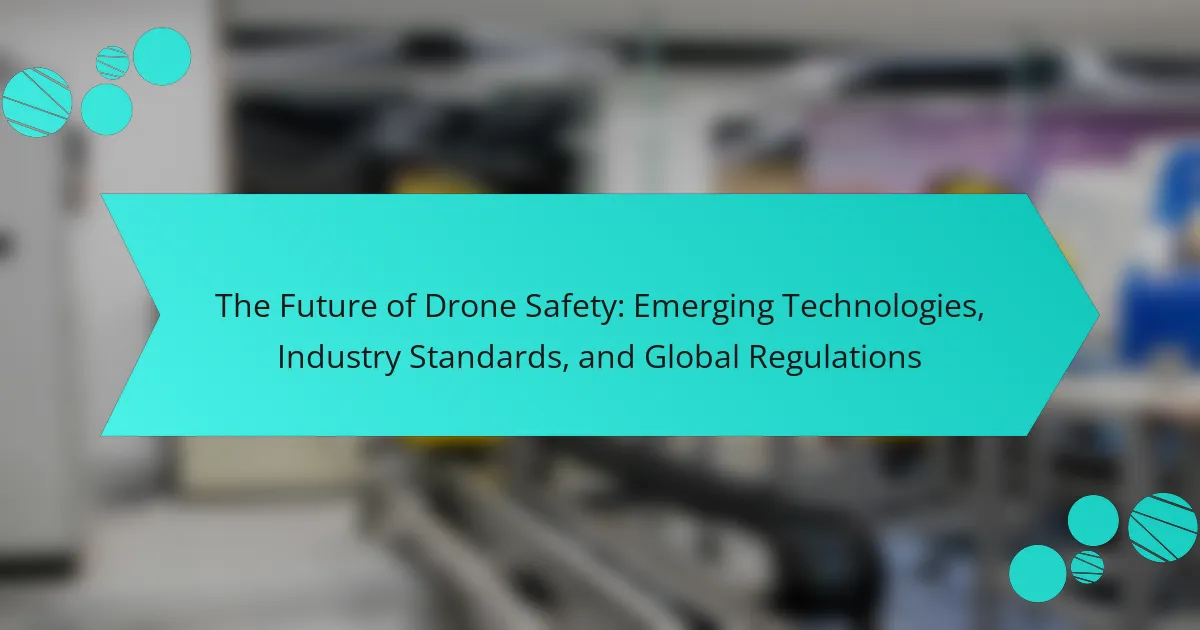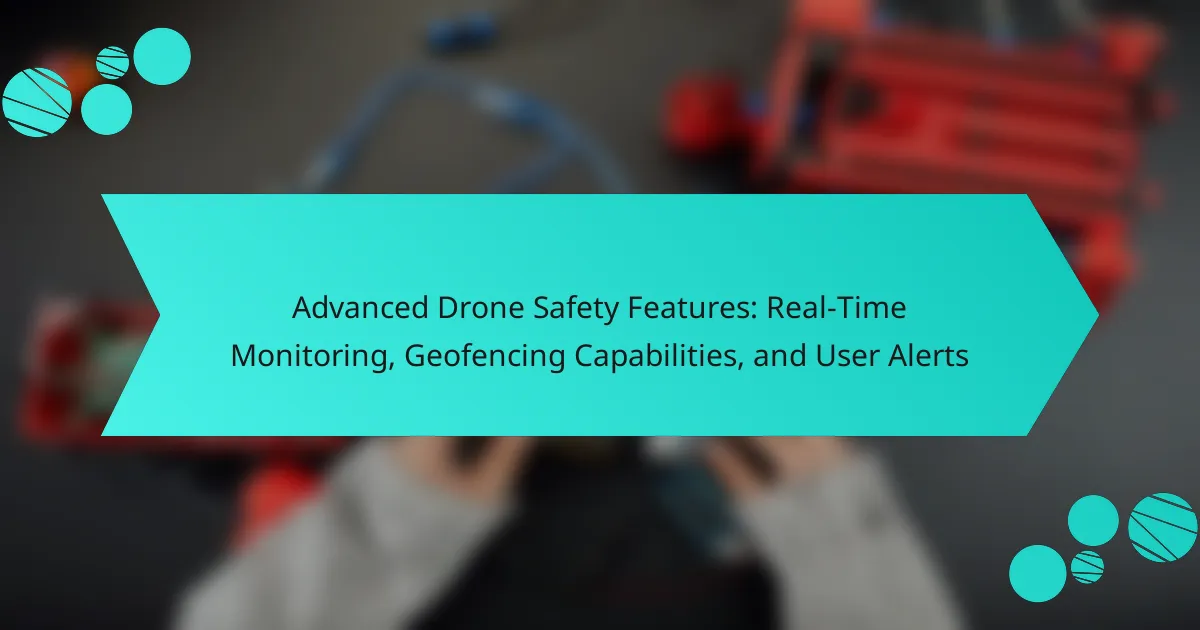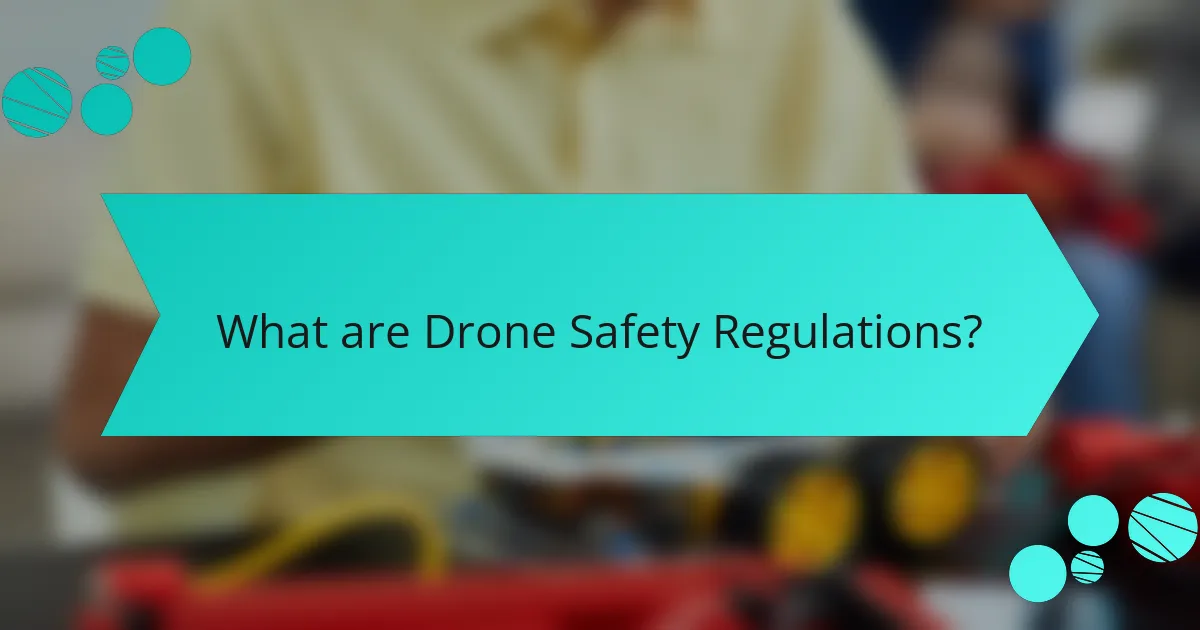
What are Drone Safety Regulations?
Drone safety regulations are rules established to ensure the safe operation of unmanned aerial vehicles (UAVs). These regulations cover various aspects of drone use, including flight altitude, no-fly zones, and operational limits. In the United States, the Federal Aviation Administration (FAA) oversees these regulations. The FAA requires drone operators to register their UAVs and obtain a Remote Pilot Certificate for commercial use. Additionally, operators must adhere to guidelines regarding visual line-of-sight operations and restrictions on flying over people. Compliance with these regulations is crucial for minimizing risks to other aircraft and ensuring public safety.
Why are Compliance Standards important for Drone Operations?
Compliance standards are crucial for drone operations to ensure safety and regulatory adherence. They establish guidelines that operators must follow to mitigate risks associated with drone flights. These standards help prevent accidents and incidents that can harm people and property. Compliance also ensures that drones operate within legal airspace and adhere to privacy regulations. Furthermore, these standards promote accountability among operators and manufacturers. They facilitate the integration of drones into the national airspace system. In the United States, the Federal Aviation Administration (FAA) sets these standards, which are essential for maintaining public trust in drone technology.
What are the key Compliance Standards that govern drone use?
The key compliance standards that govern drone use include FAA regulations, ASTM standards, and ISO guidelines. The Federal Aviation Administration (FAA) regulates commercial drone operations in the United States. This includes requirements for registration, pilot certification, and operational limitations. ASTM International provides standards for drone design, performance, and testing. These standards ensure safety and reliability in drone technology. The International Organization for Standardization (ISO) offers guidelines for various aspects of drone operations, including safety management systems. Compliance with these standards is essential for legal operation and safety in the airspace.
How do Compliance Standards vary across different regions?
Compliance standards for drone operations vary significantly across different regions. In the United States, the Federal Aviation Administration (FAA) regulates drone use, emphasizing safety and airspace management. The European Union has its own regulations, governed by the European Union Aviation Safety Agency (EASA), which focus on harmonization across member states. In contrast, countries like China have strict regulations that include government oversight and registration requirements for all drones.
Asia-Pacific regions may implement varying standards based on local aviation authorities, with some countries adopting more lenient rules to encourage innovation. In Africa, compliance standards can be less developed, often resulting in a patchwork of regulations that differ from one country to another.
These regional differences stem from varying levels of technological advancement, safety concerns, and economic priorities. The FAA and EASA have established comprehensive frameworks, while other regions may still be evolving their regulatory approaches. Thus, understanding local compliance standards is crucial for safe and legal drone operations.
What role do Certification Processes play in Drone Safety?
Certification processes ensure that drones meet safety standards before operation. They verify compliance with regulations, reducing risks associated with drone usage. These processes involve rigorous testing and evaluation of drone design, functionality, and performance. By certifying drones, authorities can confirm that operators adhere to safety protocols. This minimizes accidents and enhances public trust in drone technology. For instance, the Federal Aviation Administration (FAA) mandates certification for commercial drones, contributing to safer airspace management. Overall, certification processes are vital in maintaining high safety standards in the drone industry.
What are the steps involved in obtaining drone certification?
The steps involved in obtaining drone certification include several key actions. First, an applicant must determine the type of certification needed based on intended drone use. Next, they must complete a training program that covers relevant regulations and operational procedures. After training, the applicant should pass a written knowledge test administered by the aviation authority. Following the test, they must demonstrate practical flying skills through a flight test. Finally, the applicant submits an application along with necessary documentation and fees to the aviation authority for review and approval. These steps ensure compliance with safety regulations and operational standards.
How do different types of drone certifications impact operations?
Different types of drone certifications significantly impact operations by defining the scope, limitations, and requirements for drone pilots. For instance, Part 107 certification allows commercial drone operations in the U.S. under specific conditions, such as flying below 400 feet and during daylight. This certification requires knowledge of airspace regulations and operational safety, which enhances pilot competency and safety in operations.
In contrast, a Section 333 exemption allows for more flexibility in operations but requires a detailed application process and adherence to specific conditions. Additionally, the Remote Pilot Certificate mandates ongoing education and proficiency checks, ensuring pilots remain updated on regulations and safety practices.
Statistics show that certified pilots are less likely to be involved in accidents, demonstrating the importance of proper certification in promoting safety. Thus, the type of certification directly influences operational capabilities, safety measures, and compliance with regulatory standards.
What Operational Guidelines should drone operators follow?
Drone operators should follow specific operational guidelines to ensure safe and compliant flights. Operators must always maintain visual line of sight with their drones. This is crucial for avoiding obstacles and ensuring safe navigation. They should also adhere to altitude restrictions, typically not exceeding 400 feet above ground level. Compliance with local regulations and airspace restrictions is mandatory. Operators must avoid flying near airports and restricted areas. Pre-flight checks are essential to ensure the drone is in good working condition. Additionally, operators should not fly in adverse weather conditions that could impair visibility or control. Following these guidelines helps mitigate risks and promotes safety in drone operations.
What are the essential safety practices for drone operation?
Essential safety practices for drone operation include pre-flight checks, maintaining visual line of sight, and adhering to altitude restrictions. Pre-flight checks ensure the drone is in optimal condition. This involves checking battery levels, propellers, and control systems. Maintaining visual line of sight helps operators avoid obstacles and ensures safe navigation. Adhering to altitude restrictions, such as the FAA’s 400-foot limit, prevents interference with manned aircraft. Operators should also avoid flying near airports and crowded areas. Following these practices reduces the risk of accidents and enhances overall safety.
How can operators ensure compliance with operational guidelines?
Operators can ensure compliance with operational guidelines by implementing systematic training programs. These programs educate staff on relevant regulations and best practices. Regular audits should be conducted to assess adherence to guidelines. Documentation of operational procedures is essential for accountability. Operators must stay updated on changes in regulations. Engaging with regulatory bodies can provide insights and clarifications. Utilizing checklists can help ensure all operational steps are followed. Finally, fostering a culture of safety within the organization reinforces compliance.
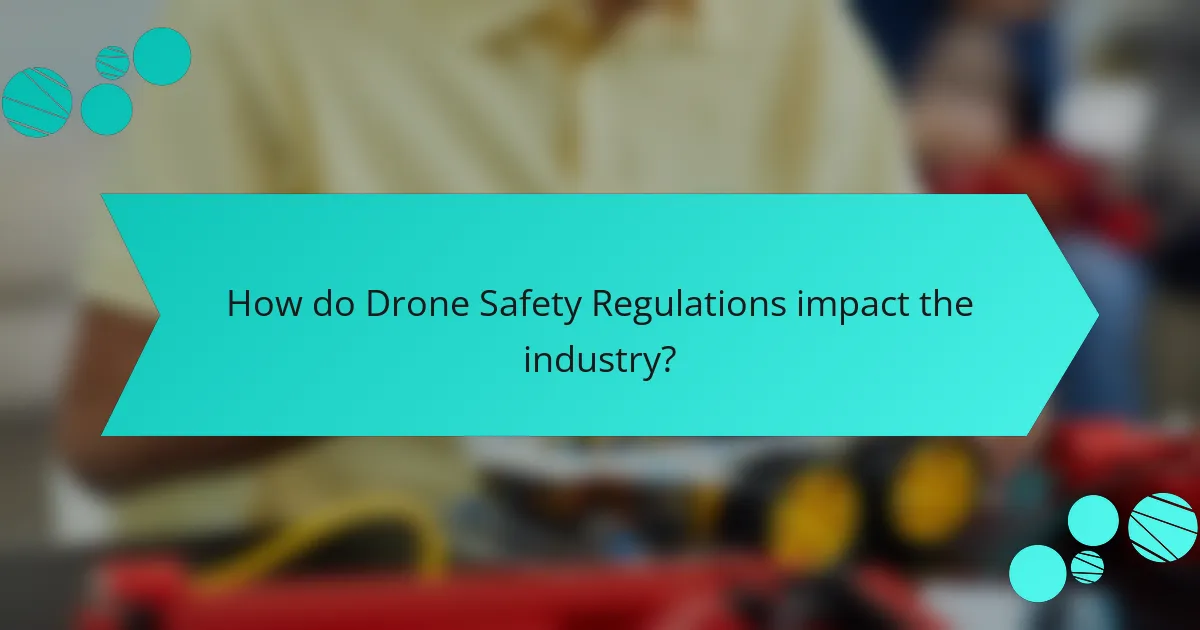
How do Drone Safety Regulations impact the industry?
Drone safety regulations significantly impact the industry by establishing compliance standards that ensure safe operations. These regulations govern various aspects, including flight altitude, no-fly zones, and equipment requirements. Compliance with regulations helps reduce accidents and enhances public trust in drone technology. According to the Federal Aviation Administration (FAA), adherence to safety regulations has led to a decrease in reported incidents involving drones. Furthermore, regulations facilitate the integration of drones into national airspace systems, promoting commercial opportunities. The presence of clear guidelines encourages investment in drone technology and innovation. Overall, safety regulations play a crucial role in shaping a responsible and sustainable drone industry.
What are the consequences of non-compliance with drone regulations?
Non-compliance with drone regulations can lead to significant legal and financial consequences. Operators may face fines that can range from hundreds to thousands of dollars. In severe cases, penalties can include criminal charges, leading to imprisonment. Additionally, non-compliance can result in the suspension or revocation of drone operating licenses. This can hinder the ability to legally operate drones in the future. Furthermore, violations can lead to increased scrutiny from regulatory agencies. This may result in more stringent oversight and additional regulations imposed on operators. Insurance claims may also be denied if an incident occurs during non-compliance. Overall, the consequences of non-compliance can severely impact an operator’s business and reputation.
How do regulations influence the development of drone technology?
Regulations significantly influence the development of drone technology by establishing safety standards and operational guidelines. These regulations dictate the design, manufacturing, and usage of drones. For example, the Federal Aviation Administration (FAA) in the United States requires drones to meet specific safety criteria before they can be operated commercially. Compliance with these regulations often drives technological advancements, as manufacturers seek to innovate within the constraints set by regulatory bodies.
Moreover, regulations can promote research and development in areas like collision avoidance systems and remote identification technologies. According to a report from the FAA, stringent regulations have led to increased investment in drone technology, enhancing overall safety and efficiency. Ultimately, regulations shape the trajectory of drone technology by fostering innovation while ensuring public safety.
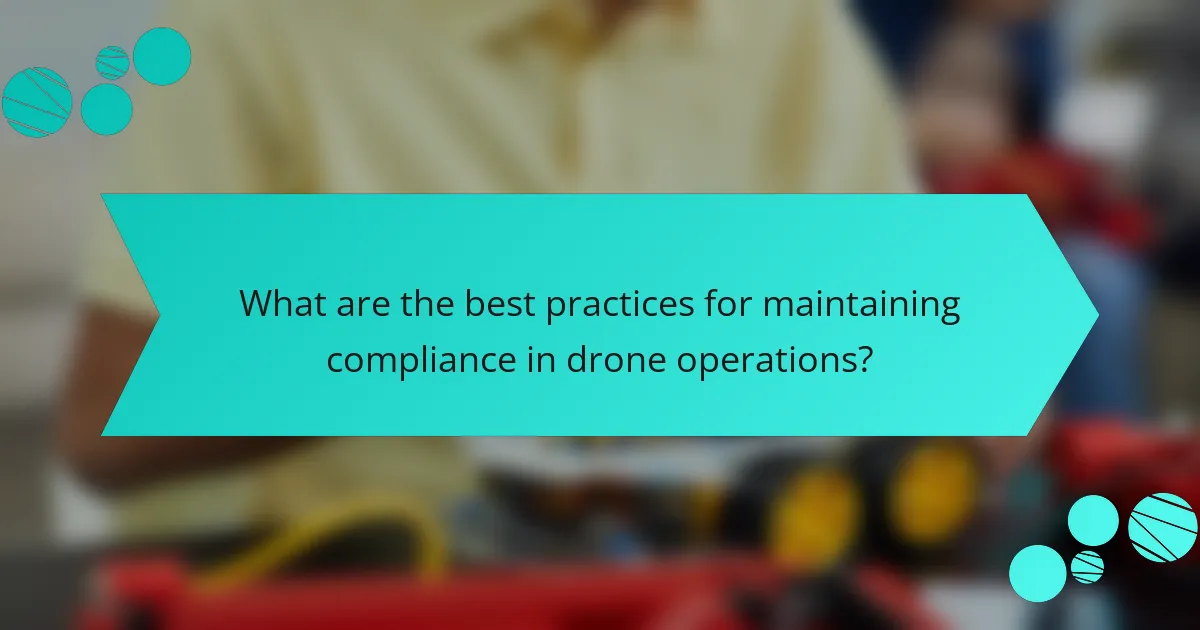
What are the best practices for maintaining compliance in drone operations?
The best practices for maintaining compliance in drone operations include understanding and adhering to local regulations. Operators should familiarize themselves with the Federal Aviation Administration (FAA) guidelines in the U.S. This includes obtaining the necessary certifications, such as a Remote Pilot Certificate.
Regularly checking for updates in regulations is crucial, as laws can change. Operators must also conduct pre-flight checks to ensure the drone is in safe working condition. Keeping accurate records of flights and maintenance is essential for accountability.
Additionally, operators should not fly in restricted airspace without proper authorization. They should also respect privacy laws and avoid flying over private properties without consent. Training for all personnel involved in drone operations enhances safety and compliance.
Finally, engaging with local aviation authorities can provide valuable insights and updates on compliance requirements.
How can operators stay updated on changing regulations?
Operators can stay updated on changing regulations by regularly reviewing official government websites. These sites often publish the latest regulatory changes and updates. Subscribing to newsletters from relevant regulatory bodies is also beneficial. This ensures timely notifications about new rules or amendments. Participating in industry associations can provide insights into regulatory trends. Networking with other operators can facilitate information sharing regarding compliance. Attending workshops and seminars focused on regulations enhances understanding. Monitoring social media channels of regulatory agencies can offer real-time updates. Engaging with legal experts in aviation law can clarify complex regulatory matters.
What resources are available for understanding drone safety regulations?
The primary resources for understanding drone safety regulations include government websites, industry associations, and educational platforms. The Federal Aviation Administration (FAA) website provides comprehensive guidelines and updates on drone regulations in the United States. The FAA’s Part 107 regulations specifically outline operational guidelines for commercial drone use. Additionally, organizations like the Association for Unmanned Vehicle Systems International (AUVSI) offer resources and training materials. Online courses and webinars from platforms like Remote Pilot 101 also help users understand compliance standards and safety practices. These resources collectively ensure that drone operators are informed about legal requirements and safety protocols.
How can operators implement a compliance checklist for operations?
Operators can implement a compliance checklist for operations by first identifying relevant regulations and standards. This involves researching local, national, and international drone regulations. Operators should then create a detailed checklist that outlines specific compliance requirements. Each item on the checklist should correspond to a regulatory standard or operational guideline. Regular training sessions for staff on compliance procedures are essential. Additionally, operators must conduct routine audits to ensure adherence to the checklist. Documentation of compliance efforts should be maintained for accountability and transparency. These steps help ensure that operations meet safety and regulatory standards effectively.
What common challenges do drone operators face regarding safety regulations?
Drone operators face several common challenges regarding safety regulations. One challenge is the complexity of compliance with varying regulations across different regions. Regulations often change, making it difficult for operators to stay updated. Another challenge is the requirement for specific certifications, which can be time-consuming and costly to obtain. Additionally, operators may struggle with understanding airspace restrictions and no-fly zones. Limited access to accurate information about these restrictions can lead to unintentional violations. Furthermore, operators often encounter difficulties in integrating drones into existing air traffic systems. This integration requires coordination with aviation authorities, which can be a lengthy process. Lastly, maintaining safety records and documentation can be burdensome for operators, especially for small businesses. These challenges highlight the need for ongoing education and support for drone operators to navigate safety regulations effectively.
How can operators overcome these challenges effectively?
Operators can overcome challenges in drone safety regulations by implementing structured training programs. These programs ensure that operators are well-versed in compliance standards and operational guidelines. Regular updates on regulatory changes can keep operators informed. Utilizing technology for real-time monitoring enhances adherence to safety protocols. Collaboration with regulatory bodies fosters a better understanding of certification processes. Engaging in community forums allows operators to share experiences and solutions. Adopting a proactive approach to risk management minimizes potential issues. Research indicates that organizations with comprehensive training see a 30% reduction in compliance-related incidents.
What are the most frequent regulatory pitfalls for new drone operators?
New drone operators frequently encounter regulatory pitfalls such as lack of knowledge about airspace restrictions. Many do not understand the importance of checking local regulations. Operating in restricted areas can lead to fines or legal action. Another common issue is failing to register their drones with the FAA. Registration is mandatory for drones over 0.55 pounds. Additionally, new operators often neglect to obtain the necessary remote pilot certificate. This certification is required for commercial operations. Ignoring maintenance and pre-flight checks can also result in safety violations. Lastly, many operators fail to keep their drone insurance updated, which is essential for liability protection.
What tips can enhance drone operational safety and compliance?
To enhance drone operational safety and compliance, operators should adhere to established regulations and best practices. Regularly check for updates in local and federal drone laws to ensure compliance. Conduct pre-flight inspections to verify the drone’s functionality and safety features. Maintain situational awareness by monitoring the environment for hazards such as people, buildings, and other aircraft. Utilize a flight log to document flight details, including times, locations, and any incidents. Implement a thorough training program for all personnel involved in drone operations. Familiarize all operators with emergency procedures and protocols. Lastly, consider obtaining appropriate certifications to demonstrate adherence to safety standards. These measures collectively contribute to safer drone operations and compliance with regulatory frameworks.
Drone safety regulations are established rules governing the safe operation of unmanned aerial vehicles (UAVs), overseen primarily by the Federal Aviation Administration (FAA) in the United States. This article provides a comprehensive overview of compliance standards, certification processes, and operational guidelines essential for drone operators. Key topics include the importance of adherence to regulations, the steps involved in obtaining drone certification, variations in compliance across regions, and best practices for ensuring safety and compliance. Additionally, the article addresses the consequences of non-compliance and the impact of regulations on the development of drone technology, equipping operators with the knowledge needed for responsible drone operations.
